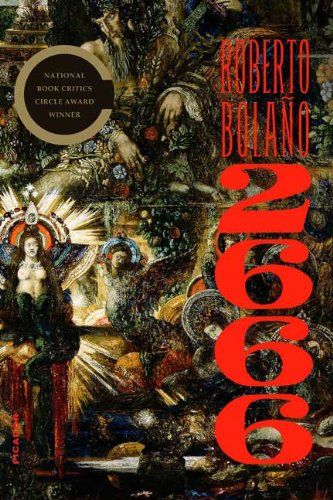 Everyone says Roberto Bolano’s 2666 is titled in a “mysterious” way. That’s a euphemism for not having any idea what it means. Part of the mystery is that 2666 never appears in any of the five sections of the novel.
Everyone says Roberto Bolano’s 2666 is titled in a “mysterious” way. That’s a euphemism for not having any idea what it means. Part of the mystery is that 2666 never appears in any of the five sections of the novel.
2666 does, however, take on the form of a date, and by a date in the far future it forecasts a kind of calamity, perhaps apocalyptic. In fact, Bolano offered rather subtle hints that he thought of that date as apocalyptic. And there’s no mistaking the triple six as an indicator of the depths of evil in the book, both the atrocities of the Nazi regime as well as the systematic slaughter of women in Mexico. 666 alone would merely communicate a symbolic fear, but when combined into a date, the horror becomes concrete, embedded in history (or in this case, the future).
Bolano’s other titles are not nearly as mysterious. The Savage Detectives takes on the structure of a detective story and includes plenty of savagery. Bolano’s alter ego, Arturo Belano, is the actual savage detective. And Nazi Literature in the Americas is (surprise!) “a biographical dictionary of American writers who flirted with or espoused extreme right-wing ideologies in the twentieth and twenty-first centuries.”
But with Last Evenings on Earth, Bolano uses the same kind of apocalyptic tone as 2666. Taken from one of the short stories, the actual story does not mention Last Evenings, but the dangerous and violent content matches perfectly with the possibility of the evening being the characters’ last. It’s a kind of final hurrah with prostitutes and gambling and multiple mentions of suicides, and portentous lines like “From this moment on he knows the disaster is approaching.” In 2666, the disaster approaches slowly, building over hundreds and hundreds of pages, but winds up drumming to the beat of an apocolypse from a mass murderer.
UPDATE: All BookFox posts on 2666.

3 comments
Actually, there’s a reference to 2666 in Bolano’s book “Amulet.” In it, (page 86 in the hardcover edition), Bolano describes walking down Avenida Guerrero at night, and compares it to a cemetery “…a cemetery in the year 2666, a forgotten cemetery under the eyelid of a corpse or an unborn child, bathed in the dispassionate fluids of an eye that tried so hard to forget one particular thing that it ended up forgetting everything else.”
Ooo, thanks for the quote. I meant only that the title wasn’t mentioned in 2666 itself, but that’s very interesting, how he connects the date to a cemetery/corpses/forgetfulness. Not quite apocalyptic, but certainly just as morbid.
“Pero Cesárea habló de los tiempos que iban a venir y la maestra, por cambiar de tema, le preguntó qué tiempos eran aquéllos y cuándo. Y Cesárea apuntó una fecha: allá por el año 2.600. Dos mil seiscientos y pico.”
Los detective salvajes, p.596